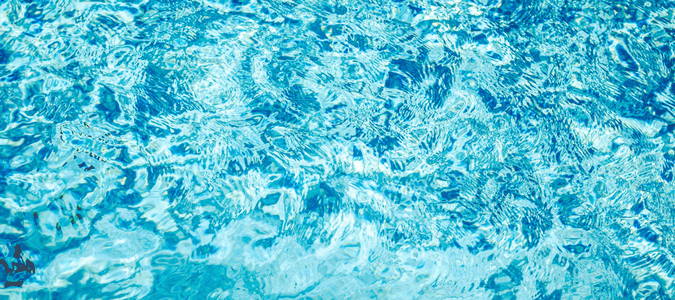
Last year you finally bit the bullet and did it: you got a backyard pool as a way to beat the Southern heat. And boy, were you glad you did. Few things are better when the summer sun is beating down than cooling off in your pool.
Recently, you decided to take a late afternoon dip. But within a few moments of settling into the water and closing your eyes to relax, you feel a tiny pinprick. Then another. Could that have been another?
You open your eyes to find tiny bugs crawling on you and quickly race to the shower to rinse off.
What was that? Probably thrips. And they might not be the only bugs lurking in or around your pool.
Having tiny bugs in your pool can become a major annoyance, especially when you look forward to spending time relaxing poolside. Below, we will go over several different types of bugs you might encounter near your pool and what you can do about them.
Let’s start with thrips.
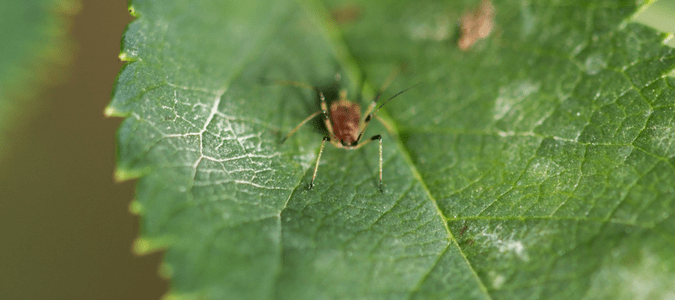
How To Identify Thrips In Pool Water
How do you know if you’re dealing with thrips in your pool? Look at your plants.
Huh? How will this let you know if they’re in the pool?
Here’s the thing. There are a lot of thrip species, and almost all of them eat and live near plants. When there’s a ready water source, like a pool, they also tend to flock toward it, but even if you’re looking for them, you might not see them there.
Why? Because they’re ridiculously tiny – adults are less than 1/20 of an inch long!
So why look at your plants?
Because if thrips are eating them, you’ll probably notice both white scarring and black dots. The white is where the thrips have eaten away at your plant, and the black is what they’ve excreted after feeding.
Something else that’s important to know about thrips is that they don’t bite. So what about that “pinprick” feeling mentioned above?
That happens, but it’s not so much “biting” as “probing.” Basically, they’re checking you out to see if you’re a tasty plant. Once they discover that you’re not, they’ll leave you alone.
Though, this is a small comfort if you’re “probed” by dozens of the little guys. Moreover, in some cases, their “pinpricks” have been known to cause itching and even a slight rash. Mostly, they’re just annoying to deal with.
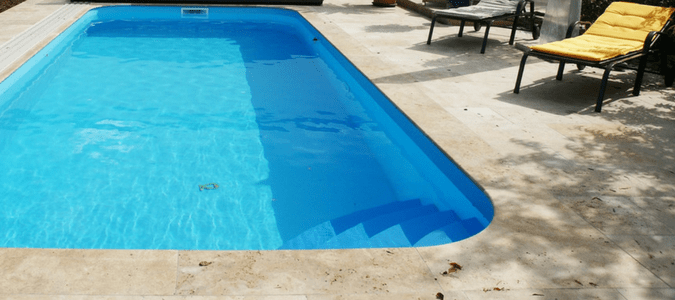
How To Identify Gnats In Pool Water
Gnats like to lay their eggs in damp places so that they may be attracted to your pool. Two things make gnats truly frustrating to deal with–in the water and out:
- They move in swarms, so you won’t just be dealing with one or two but an obnoxious cloud of bugs.
- They don’t suck blood like mosquitoes, but these insects slice open your skin to get to it. Consequently, a gnat “bite” can be pretty itchy and even painful.
So how do you know if you’ve got gnats near your pool?
Generally speaking, you’ll recognize gnats by their tendency to swarm. Specifically, if you see swarms of bugs flitting around your plants, you’ve likely got gnats.
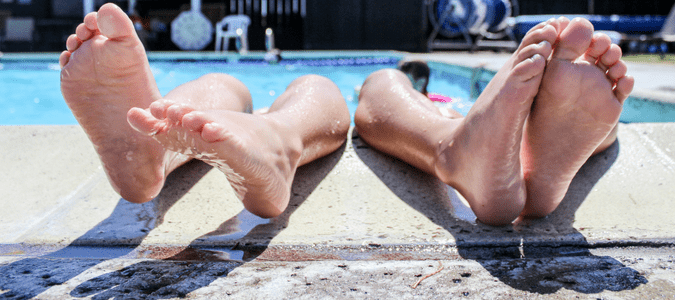
How To Identify Pool Mites
First, the good news. The mites you are most likely to find in your pool do not live and feed on people. Most likely, you’re dealing with water mites, which typically feed on the larvae of other insects.
Now for the bad news: no one wants a pool full of these itty-bitty red bugs because they make your pool look gross. Also, their very existence is probably a sign that you have other bugs in the water. Did we mention that your pool mites were likely initially transported there by another type of pool bug: water boatman?
This is important because if you get water boatmen living in your pool, they will attract backswimmers. If there’s one type of bug you absolutely do not want in your pool, it’s a backswimmer. Why? These troublesome visitors will absolutely bite if handled, and it hurts about as much as a bee sting.
Since we mentioned water boatmen and backswimmers, we should also mention other bugs that can be a problem near pools as well, like mosquitoes, which the water can attract, the lights if you’re swimming at night, and–of course–you if you’re relaxing at the edge of the pool. Ants can also be a problem because they may set up colonies nearby and treat the pool as a water source.
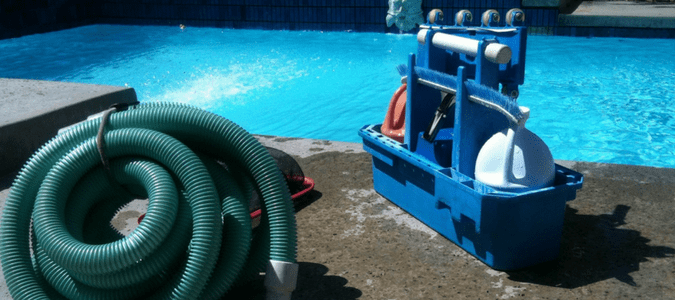
How To Keep Bugs Out Of Pool Water
So, now we get to the million-dollar question: how can you keep these pesky bugs from spoiling your next pool party?
Let’s start with getting rid of the current bugs in the pool. There are a couple of different things that you should do.
Use Shock Chlorination
Want to kill organic material in the pool? Shock chlorination will do the trick, and you should do it at least weekly while you have a problem–preferably twice a week.
How does it work? Typically, you want the chlorine level in your pool to be between 1.0 and 3.0 PPM (parts per million). When you engage in shock treatment, it should add 5.0-10.0 PPM to the chlorination level of your pool. Afterward, wait until the chlorination level returns to normal before returning to the pool. This can take up to 48 hours.
Follow Up With Algaecide
Once your chlorination level returns to 1.0-3.0 PPM, it’s time for an algaecide. Check the directions on your specific product to see how much you should use. For about 12 hours, remove any dead algae with a vacuum and brush.
Vacuum And Brush
You don’t want to skip this step to ensure you have removed all the dead organic material from the pool. You should be vacuuming and brushing routinely anyway, as these tasks are essential to regular pool maintenance. Spend 10-15 minutes every day doing so, and it will be a lot easier to control any pool bug problem you might have.
The best strategy is to overlap your strokes on the floor and walls when brushing, then end with good vacuuming.
Skim Your Pool Every Day
Yes, that’s right–every day. Skimming is another way to get organic material from your pool that might attract pesky insects. Remember, if there’s nothing to eat in the water, they will vacate the premises quickly.
Preventing Swimming Pool Pests
What if you don’t have pool pests but want to keep it that way? Here are some pool bug prevention tips.
Don’t Plant Near The Pool
Some of the bugs on the above list don’t live or feed in the water. Instead, their food source is the plants in your yard. The farther away your plant beds are, the less likely it is that any bugs feeding on them will make the trek all the way to your pool.
At the very least, you should keep several feet around the pool clean and clear of plant life–even overhanging trees, if possible.
Place Lighting As Far Away As Possible
Know what attracts bugs at night? Lights! For this reason, you should ideally keep any lighting at least 30 feet away from the pool’s edge.
If you need closer lighting for night swimming, kill two birds with one stone by investing in citronella candles.
Find Somewhere Else For Your Trash
Another thing that attracts bugs: trash. Identify the farthest possible point from your pool and put the garbage cans there.
Clear Standing Water
Yes, the pool itself is standing water, but that’s what all that regular maintenance above is for. Nothing else with standing water or dampness should be dumped or cleaned regularly.
That includes birdbaths, pet water dishes, water accumulating in wheelbarrows and outdoor toys, etc.
In terms of damp areas, clear out your gutters regularly and aerate the lawn periodically.
Although they aren’t tiny bugs, taking these swimming pool mosquito control steps will help make your time spent near the pool more enjoyable.
Use Vinegar
This tip is excellent if you deal with gnats around the pool. Put vinegar in plastic bottles near the water and poke holes in the lid. Any curious gnats that pop by will crawl in through the holes but cannot fly out. Instant bug trap!
ABC Can Help Eliminate Pool Pests
Most pool owners realize quickly that much maintenance goes into keeping up their pool. It may not sound like a lot to say you should clean for 10-15 minutes a day, but it gets a lot harder during times of the year when other priorities take over. Moreover, that’s not counting the time you spend doing extra maintenance, like twice-weekly chlorine shocks. And if you have a severe bug problem, all bets are off. If you don’t have the time or energy to do it yourself, or if you’ve gone the DIY route and things aren’t improving, don’t hesitate to ask ABC for a pool cleaning. Our experienced technicians understand what it takes to keep your swimming pool in top condition and eliminate bug problems around your pool and inside your home. Schedule a service today.